- When Are Raspberries Ready to Pick: A Comprehensive Guide for Gardeners - July 11, 2024
- When Are Red Delicious Apples Ready to Pick: Essential Harvesting Tips - July 11, 2024
- When Are Snow Peas Ready to Pick: Essential Harvest Tips - July 11, 2024
Knowing all the types of pumpkins is essential for cookaholics and decoration addicts. Every type of pumpkin, in fact, will have a different color, taste, and pulp texture. As such, you’ll realize that not every type of pumpkin is ideal for every recipe or purpose.
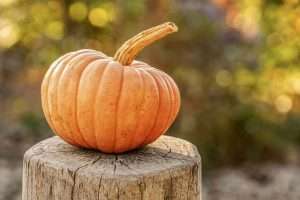 This guide to the main types of pumpkins presents an overview of the different pumpkin groups, and then it gives you details on size, shape, color, and uses for 40 individual varieties of different colored pumpkins.
This guide to the main types of pumpkins presents an overview of the different pumpkin groups, and then it gives you details on size, shape, color, and uses for 40 individual varieties of different colored pumpkins.
Pumpkins are a diverse group of fruits – and yes, a pumpkin is a fruit, according to scientists who study plants.
By some counts, there are over 150 separate species of pumpkin plants and many hundreds of varieties of every shape, color, and size you can imagine.
Let’s sort them out.
JUMP TO TOPIC
- What Are the Different Kinds of Pumpkins?
- Pepo Pumpkin Breeds
- Moschata Varieties of Pumpkins
- Maxima’s Giant Orange Pumpkins and More
- Mixta’s Different Colored Pumpkins
- Talking About Types of Pumpkins
- Top Orange Types of Pumpkins
- Red-Orange Types Pumpkins
- Tan Pumpkin Breeds
- Green Pumpkins
- Blue-Green Types of Pumpkins
- White and Other Unusual Types of Pumpkins
- Mini Pumpkins
- Other Unusual Types of Pumpkins
- Pumpkin-like Squash
What Are the Different Kinds of Pumpkins?
There are four main types of pumpkins: Pepo, Moschata, Maxima and Mixta. These large groups are further divided in dozens of species.
In general, pumpkins belong to the plant family called Cucurbitaceae, or cucurbits for short. Cucurbits contain four sub-groups with all the different pumpkins we use for Jack-o’-lanterns, pumpkin pies, and winning prizes at county fairs.
Cucurbits include a total of around 960 distinct species of plants, including melons, summer squash, cucumbers, winter squash, decorative gourds, and all varieties of pumpkins.
Here’s an overview of the four main types of pumpkins:
Vibrant green to orange color pumpkin, small to medium-sized. Ideal for carving spooky Jack-o'-lanterns, baking delicious pies, and crafting savory dishes.
This is a medium-sized pumpkin, with tan and yellow skin. Ideal for pies and carving, it's a versatile choice for your fall festivities and delicious baked treats.
Various colors: vibrant orange, blue, and blue-green hues. You can find it in small to large sizes. Perfect for carving and winning prizes.
A small to medium-sized gourd with vibrant skin colors ranging from orange to blue, red, and multicolor. It's perfect for both decorative displays and adding flavor to your favorite recipes.
- Small pumpkins generally weigh between 2 and 10 lbs. Mini pumpkins are an especially small type, weighing only a pound or two.
- Medium-sized pumpkins weigh between 10 and 25 lbs.
- Large and jumbo weigh over 25 lbs.
- Jumbo varieties routinely produce 100 lb. pumpkins.
Each pumpkin group contains cultivars (also called varieties) with fruits suitable for pies and other types of cooking, and decorative uses, such as carving, painting, or displaying ‘as is’ for its natural beauty. Some varieties are right for more than one purpose.
Pepo Pumpkin Breeds
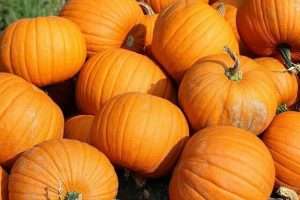
Cucurbita Pepo species also include the familiar summer squashes zucchini, crookneck, and scalloped squash, and acorn winter squash, along with numerous cultivars of traditional orange pumpkins.
Pepo pumpkins have bright, yellow to orange flowers and pumpkin fruits with thick, deep-orange rinds and stiff, grooved stems.
A classic example of a Pepo pumpkin is the Connecticut Field cultivar, a Native American heirloom people have grown for hundreds of years and continue growing today.
Moschata Varieties of Pumpkins
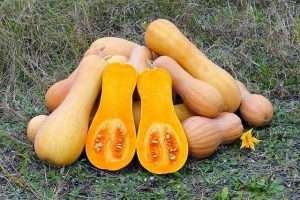
The Moschata pumpkins deserve attention if you love pumpkin pie and other baked goods containing pumpkin pulp. Moschatas include the traditional cultivars used in canned pumpkin products and many pumpkin pie recipes.
People also call some Moschata varieties “cheese-wheel” pumpkins due to their slightly squat shape, resembling a round of cheese.
Another well-known Moschata species that’s not a regular pumpkin is butternut squash, a tasty and nutritious winter squash you can bake and use in soups. Long Island Cheese is a famous pumpkin pie cultivar of the Moschata cucurbit group.
Maxima’s Giant Orange Pumpkins and More
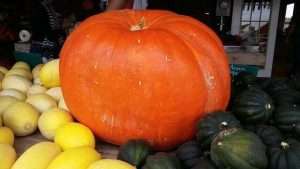
As the name Maxima implies, this is the group including pumpkins of enormous size, which win prizes at county fairs for size and weight. One-hundred pounders are common in this class, and the weight record for a Dill’s Atlantic Giant Maxima type pumpkin is a whopping 2,323.70 lbs.!
The Maxima group also includes many winter squashes, such as banana squash, Hubbard, turban squash, and some unusual pumpkin varieties like the Australian variety, the grey to blue-skinned Jarrahdale pumpkin.
People often use winter squash in decorative displays along with pumpkins. The Hubbard is dramatic for its shape, large size, and pleasing dark-green colors. Turbans come in interesting hat-like shapes and a wide range of alluring hues.
Mixta’s Different Colored Pumpkins
Fruits of the Mixta pumkin type commonly have a bulbous bottom and narrow top. Many varieties of miniature pumpkins are also in the Mixta group. In short, we can say that among the different types of pumpkins, Mixta includes the most unusual.
Mixtas span a color range, including:
- Orange
- Yellow
- Blue
- White
- Green-blue
- Grey
Mixtas make incredible decorations, given how many unusual shapes and different colored pumpkins you can find. Many are also edible.
The Mixta group also includes the Cushaw Squash. Cushaw Squash doesn’t look much like a traditional pumpkin, although it is used for pies. In outward appearance, it resembles an overgrown, bottom-heavy zucchini with a tough skin.
Talking About Types of Pumpkins
Knowing some pumpkin vocabulary allows you to talk more knowledgeably with growers at farmers markets, produce managers at grocery stores, and business owners when you see a pumpkin display that catches your eye in a shop or restaurant.
Here are a few of the most essential pumpkin-related terms:
- Skin or Rind refers to the outer layer of the fruit.
- Flesh is the interior of the fruit.
- Color can mean the tone of the skin or the flesh.
- Texture refers to the feel of the skin and also the creaminess of the cooked flesh.
- Ribs are the up and down ridges on the surface of the fruit.
- Handle is another name for the stem.
- Keeper means fruit with good storage qualities.
- Carve-ability means how easy it is to cut decoratively using a knife or carving kit.
- Heirlooms are varieties with seeds you can grow out for the same type of plant.
- F1 or Hybrid means the variety is a cross of different plants, and seeds don’t grow out true.
Now, let’s dive into 40 of the most outstanding types of pumpkins, grouped by color and size.
Top Orange Types of Pumpkins
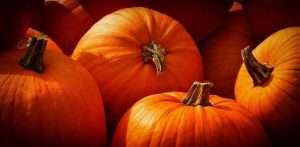
Orange pumpkins are classics for carving, and many make good pies, cookies, and baked goods. Orange pumpkins even look good just sitting in the right spot, minding their own business.
Small orange pumpkins are between 5 and 10 lbs. Small pumpkins often have smooth skin that’s easy to paint.
– Top Varieties Include:
- Baby Pam is excellent for pumpkin pie with a smooth-skinned fruit also suitable for painting or carving. You’ll find dark orange inside and outside.
- Early Sugar Pie is a classic New England style variety for pies. It has a string-less interior with bright orange flesh that also carves well.
- Winter Luxury is a popular pepo heirloom weighing around 6 lbs. with a netted, buff-orange skin and sweet flesh.
- Orange Princess is a fast-growing variety with slightly flattened fruits and deep-orange flesh and fruit averaging 5 lbs. each.
Mid-sized orange pumpkins range from about 10 to 25 lbs.
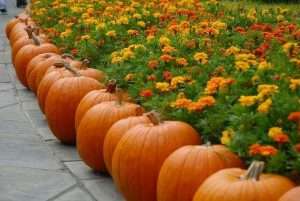
Good Examples Are:
- Gladiator F1 produces uniform fruits weighing in at 20 to 25 lbs. This large pumpkin has dark orange-colored skin and flesh, attractive ribbing, and long, sturdy handles.
- Connecticut Field Pumpkin is a classic and traditional American carving pumpkin also good for pies. Bright orange in color with slight ribs, it produces fruits of varying sizes between 15 and 25 lbs.
- Hannibal is an F1 hybrid that grows in 95 days, producing 18 to 25 lbs. fruits. Its color is dark orange with pronounced ribs. Hannibal is one of the best Jack-O-Lantern carving pumpkins.
- Jack-o’-Lantern grows uniform fruit averaging 10 lbs. The skin is medium orange and smooth with minimal ribbing, perfect for carving or painting.
Large and jumbo orange pumpkins routinely grow as big as 25 lbs. Many grow much larger.
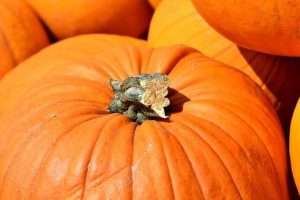
Some Favorite Varieties Include:
- Atlantic Giant is a record-holder for size with pink-orange skin and 50 to 100 lb. fruits typical.
- Prize Winner is another giant pumpkin seen at county fairs, winning prizes for size and weight. This variety has a bright orange skin and looks more pumpkin-like than some other jumbo pumpkins.
- Big Moon heirloom pumpkins routinely grow to 200 lbs. as long as you tend the plants carefully allowing only one fruit per plant.
- Kratos is a pumpkin of 20 to 30 lbs. with a large and sturdy handle and a faster-growing time than many other jumbo pumpkins.
Red-Orange Types Pumpkins
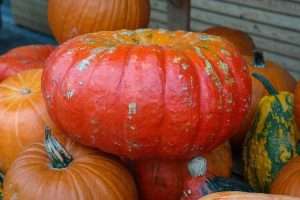
- Sun Spot grows in about 75 days, producing small fruits about 1 ½ lb. each with dark, tasty flesh and reddish-orange exterior.
- Red October is a bright red-orange pumpkin with 5 to 6 lbs. fruit useful for decoration or eating.
- Cinderella pumpkin variety is also called Rouge vif d’Etampes, meaning ‘bright red.’ The 10 to 15 lb. fruits have the flattened shape of the ‘cheese-wheel’ type, reminiscent of Cinderella’s carriage. With smooth orange-red skin and moist flesh, this variety is excellent for decoration and pie-making.
Tan Pumpkin Breeds

- Long Island Cheese is a traditional heirloom variety with small to medium-sized fruit, deep-orange flesh, and a tan-orange skin. An excellent keeper, this is a classic pumpkin pie pumpkin.
- Autumn Buckskin F1 is a hybrid pumpkin bread by the Libby Fruit Company developed for canned pumpkin products. It also grows well in home gardens, producing flat-shaped, tan-skinned pumpkins averaging about 8 to 10 lbs.
- Fairytale F1 is similar to the Cinderella pumpkin variety, but it has a unique wood-like color on cheese-wheel shaped fruits, averaging about 15 lbs. An excellent dual-purpose pumpkin for decoration and eating.
Green Pumpkins
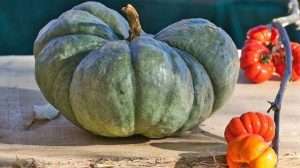
One type of pumpkin that’s green when mature looks more like winter squash and is a Japanese cultivar in the maxima group.
- Kabocha Squash is also known as the Japanese Pumpkin. This green pumpkin is similar to butternut squash in taste and acorn squash in appearance. It has a sweet taste and is useful for pie making and other types of cooking.
Blue-Green Types of Pumpkins
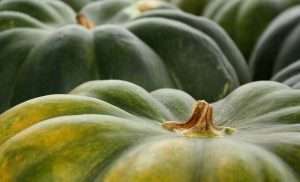
- Jarrahdale pumpkins are an excellent example of a blue-green variety with mid-size fruits. Many blue pumpkin varieties, including Jarrahdale, come from Australia.
- Blue Lakota, a North American heirloom with shallow ribs and a pear-shape that’s great for pies and steaming.
- Blue Doll, is an F1 hybrid with a deep, unusual bluish-green color and deep ribbing on 15 to 20 lb. fruits. This cultivar is excellent for pumpkin pie, soups, and steaming.
- Early Jarrah is another grey-green variety with large, flattened fruit in the 15 to 25 lb. weight range. This variety is a prolific producer and a good keeper.
White and Other Unusual Types of Pumpkins
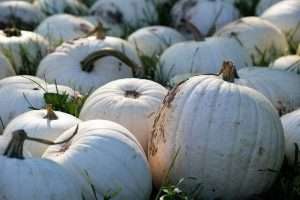
White pumpkins aren’t good keepers, so be ready to remove them from a display or use them up before they begin to fade in a week or two. Many white pumpkins have attractive orange flesh with good texture and eating qualities.
Popular white pumpkin varieties include:
- Caspar is a good-sized pumpkin of 10 to 12 pounds, with slightly flat fruits with smooth skin, perfect for carving or painting. They are also edible.
- Lumina is a 10 to 12 lb. white pumpkin with a tasty orange flesh good for making pumpkin pie and other desserts. Lumina is also a good keeper.
- Snow White has small, white-skinned fruit produced on fast-growing plants. Fruits weigh in on average at 3 to 5 lbs.
- Polar Bear stays white when the fruits are fully mature, unlike some other white pumpkin varieties. Large fruits on this cultivar weigh in at 30 to 60 lbs. The fruit is useful for decoration or eating.
Mini Pumpkins
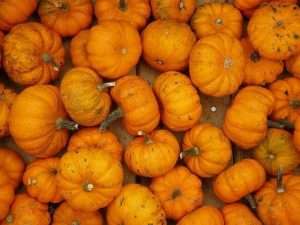
Because they are so small, carving mini pumpkins is difficult. Instead, most people use mini pumpkins by displaying them in baskets, bowels, or set out on a tabletop or other surface, sometimes with larger pumpkins in the mix.
The skin of many mini pumpkins is smooth, allowing for easily painted decorations.
Popular varieties of mini pumpkins include:
- Baby Boo is a pure white pepo pumpkin variety with fruits that fit in the palm of your hand. This cultivar produces an abundant crop of adorable mini-pumpkins ready for Halloween. Harvest them before they are fully mature because they start to turn yellow if you leave them on the vine for too long.
- Orange Cutie is a bright red to orange miniature pumpkin weighing between 1 ½ and 1 ¾ lb. These plants reliably produce a good crop of decorative and edible fruit.
- Bat Wing is a hybrid mini pumpkin with unusual green, wing-like designs on an orange background appearing on about one-third of the fruits. Tiny fruits weigh only ½ to 1 lb.
- Baby Bear is a popular mini pumpkin with dark orange skin and fruits of about 2 lbs. This variety also has strong, slender, long handles, making it easy for children to hold and carry.
- Munchkin produces a uniform crop of mini pumpkins weighing 1 ½ lb. each with yellow-orange, smooth skin, and mild ribbing.
Other Unusual Types of Pumpkins
Here are some popular unusual pumpkin varieties you can find at farmers’ markets, produce stands, and supermarkets.
- Knucklehead has a slightly oval shape, and it also comes with green warts and bumps covering its orange skin, giving it an especially creepy appearance. This cultivar weighs in at 10 to 12 lbs. Despite its strange appearance, Knucklehead pumpkin is perfectly edible and delicious.
- Galeux d’Eysines is an heirloom variety with unique, pinkish skin covered in odd warts and bumps. The fruits are cheese-wheel shaped, weigh 10 to 15 lbs. and store well for months.
- Marina Di Chioggia is another warty heirloom with green skin and sweet, yellow flesh suitable for cooking. Fruit varies from 6 to 12 lbs.
- Japanese Black Pumpkins have jet-black skin with a bumpy texture and orange flesh, often used in stir fry and tempura recipes. This pumpkin variety also freezes well. Fruits grow to about 4 lbs.
- White Cushaw looks similar to the green Cushaw Squash, except its skin is a bone-white color. White Cushaws grow to between 5 and 15 lbs. Their unusual shape adds an attractive element to decorative displays, and they also have excellent culinary qualities.
Pumpkin-like Squash
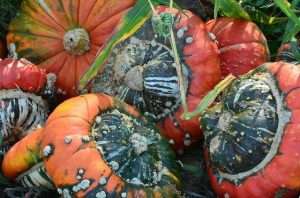
- Close relatives of the pumpkin are pumpkin-like squash with the same uses as regular pumpkins. Turban squash is an excellent example of this group of cucurbits.
- Turban squash has an interesting shape resembling a hat, with a flat, round circumference and what looks like a second fruit popping out of the top called a blossom end button.
- Turbans squash are often multi-colored, mixing orange, cream, white, green, red, and yellow into the same fruit rind, and the colors can vary from the top to the bottom of individual fruit.
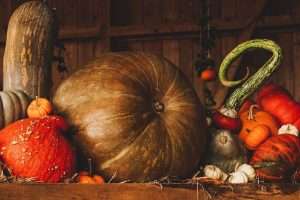
To be sure, these pumpkin-like squash are not so good for carving or pies, but they are excellent to eat in soups, stews, and as a steamed vegetable.
Here are some top varieties of turbans and other pumpkin-like squash:
- Turk Turban produces scarlet-red fruit of 3 to 5 lbs., making it an attractive choice for decorations.
- Sweet Dumpling is a delicate variety of winter squash with a thin, white and green mottled skin and delicately flavored yellow flesh.
- American Tondo is an ornamental squash when fully mature and an edible squash when fruits are young. The skin is orange with broad green vertical stripes on a heavily ribbed exterior with a sturdy handle on top. Fruits vary in weight from 6 to 14 lbs.












